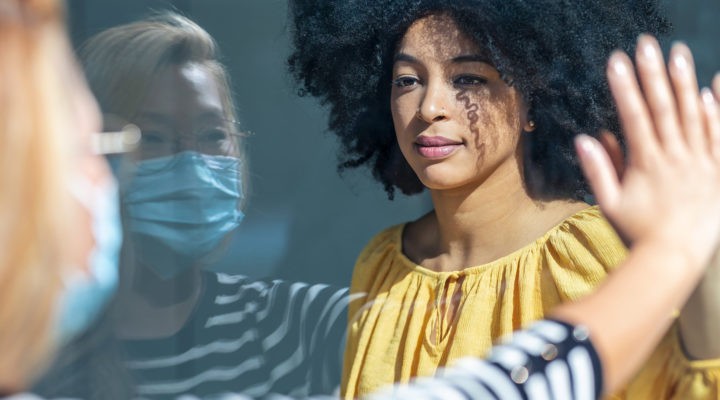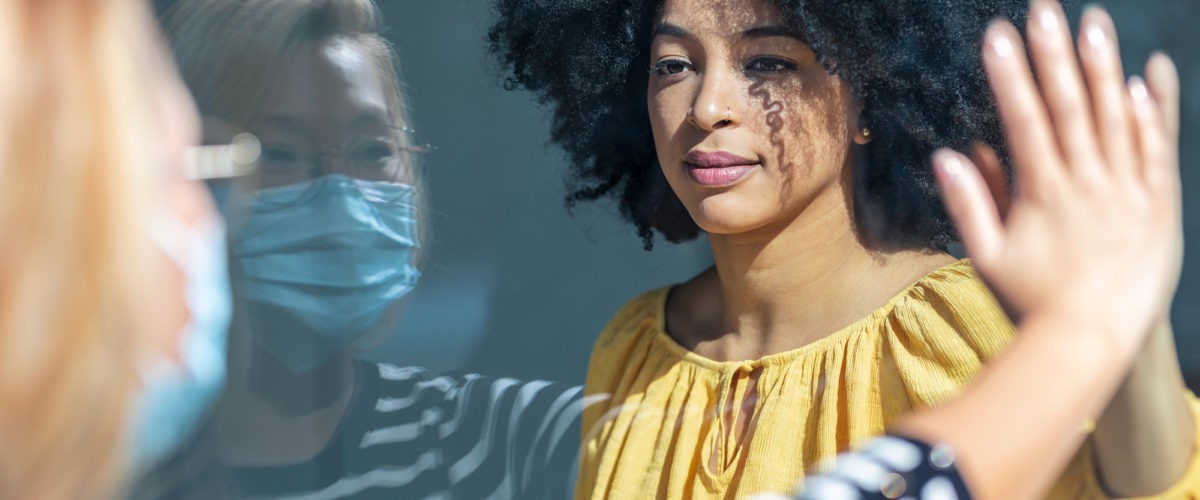Half my seminary education was on Zoom. I completed the final year and a half of a three-year master of divinity degree from the desk in my bedroom. Like everyone else, the pandemic moved my life online.
It’s a strange thing to discuss God and all things sacred while sitting alone in a room — my eyes glazing over as I listened to virtual, floating heads spout idealist seminarian views of faith and justice from their little boxes on my screen. Occasionally, I would have a moment of realization when I mentally stepped back from the situation to see how odd it was that I was essentially discussing theology with my computer.

Laura Ellis
Before the pandemic, I was involved in the community at my seminary, leading a student group and frequenting community events and lectures. But after things moved online, I couldn’t bring myself to voluntarily spend even one extra hour staring at a screen. Between virtual classes and three online jobs, I sometimes spent more than seven hours a day on Zoom. So when I was invited to additional online gatherings, I never went, no matter how worthwhile the topic.
Looking back on my final three semesters, I miss the stirring conversations at these events and the powerful connections at the chapel services. I lament over the fact that there was no graduation ceremony or party for my cohort. But more than missing these big gatherings, I mourn the loss of the little things — like the community we fostered over casual lunches and coffee trips, the impromptu theological conversations in the hallways and the natural class discussions that only come from the ability to read someone’s body language.
Not all interactions can be planned via Zoom. Some connections are lost without the ability to be near the physical bodies of others. But graver than missed connections and distanced community, I wonder how our ability to care for and empathize with others has changed in this digitalized era.
We need physical community
How can we care about the pain and marginalization of bodies in a time when physicality is seen as little more than superfluous to community and justice?
Technology is an amazing conduit that allows life to continue in a time where congregating in person is unsafe. But when daily communication and connection is relegated to digital, bodiless heads bobbing around our screens, we devolve into a pandemic of disembodiment.
“How can physical communities rebuild when fear is the instinctive reaction to being near others?”
When lockdowns were lifted, many experienced difficulty transitioning back into society. Some people were afraid to be around others, especially in crowded spaces. While this reaction is warranted in an age of an airborne pandemic, the fear of being close to other bodies is unnatural. How can physical communities rebuild when fear is the instinctive reaction to being near others?
Humans need physical community. We need close proximity to other bodies. We need to feel safe in our own bodies and at home in the physical communities we are a part of.
As we begin to reconsider ways to reconstruct in-person church and community, we must be attentive to the effects of this socially distanced way of life on our perceptions of embodiment.
Churches should ask: What happens to our conceptions of bodies and physical experiences when bodies disappear from daily interactions?
Bodily pain does not translate online
When COVID hit Boston, I lost one of my jobs. I was working at a bed and breakfast that was forced to close its doors permanently when tourists stopped visiting the city. I found another job archiving digital files for a library. Instead of talking to guests and providing physical hospitality, I spent my hours converting, renaming and dragging files into new folders on a Google drive.
My tutoring job also was altered to awkward Zoom meetings. And my third job, at a local nonprofit working to end abuse in faith communities, went completely virtual as well. The nonprofit particularly struggled with the online transition. Because the work encounters bodily pain on a daily basis, it necessitates physical presence.
Part of the mission of the nonprofit was to train faith leaders on how to respond to an abused congregant. My supervisor frequently noted the difficulty of conducting effective trainings online. Faith leaders simply seemed to care less about the problem of abuse when the trainings were not in person. Without the ability to sit in the same room in the presence of one another, the content of the trainings lacked flesh, as did the victims whose stories we told.
“We quickly become numb to the pain of others when we do not see physical bodies.”
Our proximity to other bodies makes us more aware of the physical things bodies endure. We quickly become numb to the pain of others when we do not see physical bodies.
A similar effect occurs with the issue of capital punishment in this country, which is conducted behind closed doors. Unlike executions of the past, like crucifixions and lynchings, today we do not flock to prisons to watch lethal injections. While we might be aware of the statistics of inmates on death row, it is easier to ignore the pain of state-sanctioned violence when we cannot see the affected bodies.
Losing the moral motivation to resist
When society no longer can witness the physicality of things like violence, pain and injustice, physical harm remains abstract and culture loses the moral motivation to resist.
Resistance requires the visibility of bodies, which has been key for most past and present social justice movements. The sit-in movement during the Civil Rights era demonstrates people putting their bodies on the line in resistance to a society that preferred to hide and ignore their physical presence. Pride Week reclaims the narrative of LGBTQ people through protests and public parades. And last summer we witnessed the explosion of the Black Lives Matter movement through the national visibility of marches and protests in the streets.
“Today, I fear we’ve adapted so well to the loss of physical presence that bodies simply have become unimportant.”
In times where some bodies are valued more than others, society is changed only through the visibility of marginalized bodies.
Today, I fear we’ve adapted so well to the loss of physical presence that bodies simply have become unimportant. And in their unimportance, we grow numb to the oppression and violence committed against bodies we do not see.
Church communities might be able to indefinitely discuss spiritual matters on a virtual format. But if the church wants to be relevant in conversations of bodily pain, oppression or injustice, physical bodies must be visible in community.
Let’s ‘re-member’ the body
To borrow a term from Catholic theologian William Cavanaugh, the church in this time must “re-member” the body. We must recall and emphasize the importance of the physical and earthly aspects of our existence. And when it is safe to do so, we must re-member, or put back together, the church as the body of Christ through visible and physical communal gathering. Only then can we relearn that when one body is harmed, the entirety of the body of Christ is harmed.
I should mention I attend a church that is not meeting in-person. Many conversations, congregational polls and consultations with experts went into the decision to continue worshipping and communing online. The church building is scheduled to reopen to the congregation and community in a few weeks, when we will return to in-person services for the first time since the building closed in March of last year.
The most important thing at the present moment is for churches, schools and businesses to make wise decisions based on a commitment to keep the most vulnerable safe from the virus. This includes getting vaccinated, wearing masks, practicing social distancing and even staying virtual when needed. This priority cannot be blithely removed.
“When in-person gatherings again seem safe and wise, we must take into account the toll this virtual time has taken on our conceptions of the body.”
But when in-person gatherings again seem safe and wise, we must take into account the toll this virtual time has taken on our conceptions of the body.
A theology of the body
In the 14th century when the Black Death pandemic swept through Europe and North Africa, clergy fled from infected areas and failed to offer last rites to people dying from the bubonic plague. Deacons were the ones who filled this religious void as they bravely cared for the physical bodies of the infected poor. By doing so, they declared the theological value of the body and the theological value of specific bodies who were too often devalued in society.
In today’s pandemic, medical professionals offer care, vaccines and public advice on how best to tend to health in uncertain times. But like the 14th century deacons, the church still has the theological responsibility to care for the body.
May we be inspired by these deacons as we reintroduce the body to a place of theological importance in our communities. And as churches visibly re-member our congregations, let’s tirelessly rebuild our capacity for empathy and resistance as we encounter the pain and marginalization that so many bodies endure.
Laura Ellis currently serves as a Clemons Fellow with BNG. She recently graduated from Boston University School of Theology with a master of divinity degree. She is originally from Abilene, Texas.
Related articles:
The sacrament of not touching: a gift of grace made literally a matter of life and death | Opinion by Bill Leonard
The ‘tie that binds’: fellowship is disrupted and distanced, but not destroyed | Opinon by David Emmanuel Goatley


